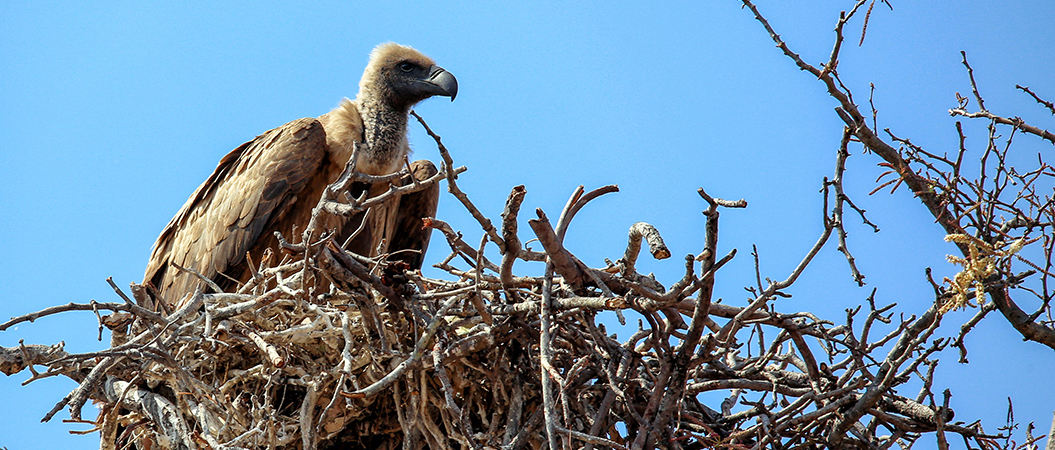Nature’s Essential Workers
Often referred to as wildlife’s “clean up crew,” vulture numbers are sadly dwindling on the African continent, but when they do pitch up – it’s a sign that nature is thriving.
Who needs supermodel looks when your USP is an iron-cast stomach that can digest the likes of rabies, botulism, cholera, and anthrax without even flinching one of your three eyelids?
“We understand that they are not pretty, but they provide a vital service, and that service is that they get rid of carcasses that would potentially spread diseases to livestock, to other wildlife, to humanity. And they provide this service for free,” says Dr. Munir Virani from the Peregrine Fund, an international NPO that focuses on the conservation of threatened and endangered birds of prey around the world.
Unfortunately, Africa’s vultures are in crisis. According to the Endangered Wildlife Trust (EWT), vultures are one of the most threatened groups of terrestrial birds on the planet. Of the six species found in South Africa, all are either endangered or critically endangered. Poisoning and poaching account for many deaths of the vulture population, as well as diminishing habitats and construction infrastructure such as power lines.
Shaun Smilie wrote an expose in the Daily Maverick (DM) two months ago point to a report by researcher Mbali Mashele. Who identified that every year between 400 and 800 vultures are killed by traditional healers for muti. “Most of the vultures are harvested within protected areas like Kruger National Park, where they [poachers] go in illegally,” says Mashele.
An author of the study, Prof Colleen Downs of the University of KwaZulu-Natal, says it’s poaching and poisoning threatening the vulture populations and a range of factors, including other wildlife such as elephants who push trees over, destroying vulture’s nests.
African vultures in crisis
South Africa is not alone in the problem. In 2019, 537 vultures died after feeding on poisoned elephant carcasses, and Dr. Beckie Garbett reported (The Conversation) that, since 2019, over 2000 vultures have been killed in Guinea Bissau.
In his 2020 Guardian article titled, “The vultures aren’t soaring over Africa - and that’s bad news,” Stephen Moss writes that from 1992 to 2007, India’s vulture population declined drastically, leading to an increased risk of disease, and points out that “there are signs that Africa’s vulture populations are also plummeting at an alarming rate.”
In 2015 BirdLife International raised the alarm that Africa’s vultures were on a direct flight path to extinction. Their awareness campaign and stellar work with conservation organisations and community NGOs on the ground have shown some positive results.
Following Asia’s example, “Vulture Safe Zones” were implemented in South Africa. These are large areas of land where homeowners agree to manage their properties in ways conducive to vulture survival. In 2019, Tswalu Kalahari Game Reserve in the Northern was declared South Africa’s first vulture safe zone. Since then, numerous safe zones have been created in South African and neighboring countries, essential as vultures are long-distance foragers.
One of BirdLife’s partners, Nature Kenya, worked with The Peregrine Fund and the Kenya Wildlife Service to create “rapidresponse vulture rescue protocols” in India. Rangers were trained to dispose of poisoned carcasses with urgency as well as gather evidence against possible perpetrators. A publicity campaign was also launched in villages across the Masai Mara, getting community buy-in. Figures show that from 2017 – 2019, the poisoning of vultures in the Mara had dropped by more than 50%.
BirdLife also has programmes underway in Nigeria, where the Nigerian Conservation Fund (NCF) has embarked on a countrywide project to end vulture poaching. “Belief-based” usage of vulture parts is the main reason, and as a result, is impacting on vulture populations throughout West Africa. The NCF is working with traditional healers to try and introduce wildlife-friendly options. As the movie industry is huge in that country, the NCF launched a documentary titled “Our Plights to Survive: Nigeria’s Vulture and Wildlife Trade Crisis” and partnered this with an ambassador campaign on social media.
Vulture recovery in Malawi
As David Attenborough tells us, we need to protect the planet’s biodiversity as we are all interconnected. An exciting example of this is the restoration of wildlife in Malawi, which has resulted in the return of the vultures.
Olivia Sievert, the Research Manager for the Lilongwe Wildlife Trust, has been working closely with conservation NGO African Parks in both Liwonde and Majete National Parks.
She points out that little scientific literature on vulture populations, breeding, and movements within Malawi. It is thought that the early 1990s had wiped out most populations. However, due to significant efforts in conservation in Malawi, there has been an increase in wildlife, and the vultures have returned.
Sievert says, “Vulture populations were noted as returning to Majete Wildlife Reserve as carnivores (lion and leopard) were reintroduced. A similar trend followed suit in Liwonde National Park with the reintroduction of cheetah. Interestingly, we now know that these populations of vultures are connected. They use Majete and Liwonde and Lengwe National Park (just to the south of Majete) to foraging roosting and nesting sites. This demonstrates how important this mosaic of protected areas is to support a healthy breeding vulture population.”
Some of the most exciting findings to date, notes Sievert, are researchers recording the first-ever documented movements of vultures between Malawi and South Africa and the first recorded White-headed vulture nest in Majete (there are only an estimated 2,500-10,000 individuals left).
While vultures may never be able to ditch their unlovable reputation, one thing is for sure – we need them for a healthy planet.
As Sir David Attenborough writes in his book, A Life on Our Planet, “To restore stability to our planet, therefore, we must restore its biodiversity, the very thing we have removed. It is the only way out of this crisis that we have created. We must rewild the world.”

